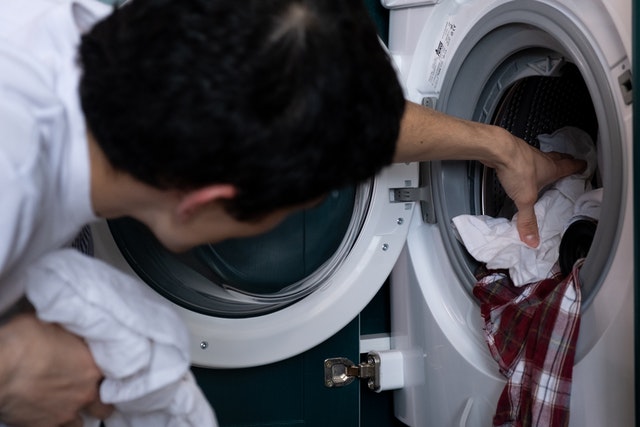It may be one of the greatest prevalent issues for all models, but when your dryer doesn’t heat up, it effectively shuts down your whole laundry area.
There are 11 probable issues that you might explore, and a few alternative remedies that you might be able to handle yourself.
At Pegasus Appliance Repair, their highly trained specialists are always there to assist you whenever you need them.
Here are some of the reasons why your dryer isn’t heating:
#1. Thermal Fuse For Use With Electric And Natural Gas Dryers
To prevent the dryer from overheating, a thermal fuse is used. In the blower housing, you’ll find it. Having a blocked or limited airflow via the discharge pipe is the most common reason for overheating.
Solutions that could be considered:
- Wipe out the dust screen to get rid of any junk that has accumulated. It may be cleaned with warm water and a gentle brush if necessary. Before reinstalling the housing, make sure it is completely dry.
- Make a visual inspection for kinks or obstructions with an inflexible vent pipe that runs from the rear of the dryer.
- Make certain that the discharge duct system leading to the outdoors is free of obstructions.
- If you are unable to clear the ducts yourself, you should call a duct cleaning service.
- When you’ve determined that all vent locations are free of obstructions, call Pegasus Appliance Repair to have the thermal fuse replaced.
#2. Solenoid For A Gas Valve, Used Only In Gas Dryers.
Gas dryers utilize two or more gasoline valve solenoid coils to release the gas valve ports, depending on the size of the gas dryer being used. As soon as the valve is opened, gas travels to the burner assembly, where it ignites the igniter, causing the burner to generate heat.
An issue with one or even more gasoline valve solenoid valves may be the cause of the igniter’s inability to spark the gas flow.
The solution that might be implemented:
- To have the pair of gasoline valve coils replaced, make an appointment with a licensed gas technician.
#3. The Igniter Is The Third And Final Cause. Only Applicable To Gas Dryers
When the dryer has to be heated, the ignition coil will light up and begin to illuminate. After showing the highest temperature, the air valve would release, the gas will ignite, and the dryer will begin to heat.
If the igniter does not heat up enough to light the gas, it is possible that it is faulty:
- The igniter is positioned within the machine, near the tube that contains the gas burner. Due to its brittle nature, it should only be changed by a qualified gas technician.
#4. Heat Source is the fourth and last cause. Only for Electric Dryers Electric.
Current travels through with a coil of warming wire, which is referred to as the heating element, to heat the clothes. This coil, which is contained inside a metal chamber, warms the air that is drawn through the chamber before blowing it into the drum.
If the element is not functioning properly, it will not heat.
The solution that might be implemented:
- In most electric dryers, the preheater is positioned underneath the bottom front panel on the correct hand of the dryer’s right side. It should be checked to see whether it is still operational. It is feasible to replace merely the coil, however, this should only be performed by a qualified expert.
#5: Heating Element Assembly Only for use with electric dryers
There are already insulators and an electric heating coil connected to the back housing in this package, so it is ready to use right away.
As mentioned in #4, if indeed the heat exchanger is not functioning properly, the air being blasted into the drum will not be heated.
The solution that might be implemented:
- If the heating element cannot be changed on its own, a repair expert should replace the whole heating element assembly.
#6: Flame Sensor, Also Known As Radiant Sensor. Only For Use With Gas Dryers
Infrared sensors, also known as radiant sensors or flame sensors, detect heat emitted by the glow plugs or burner flame.
It is in charge of opening and maintaining the gas valve when the fire is burning. If the flame goes out for whatever cause, the gas sensor will shut off the gas valve.
One of the signs of a faulty sensor is a non-functioning igniter or a fire valve that won’t turn on.
If the igniter continues to light constantly but does not open the fuel line, the electrical connections within the igniter may have been damaged and must be replaced.
The solution that might be implemented:
- If the sensor is found to be defective, call a certified gas technician who will test and repair it.
#7 Is A Problem With The Incoming Power. In The Case Of Electric Dryers Only
When there is inadequate electricity to the dryer, it is possible that the dryer may not produce any heat. For the dryers to function correctly, it requires two 120-volt alternating current legs, for a maximum of 240 volts. Because just one circuit or breaker has been tripped in this case, the dryer will sometimes be able to operate but not heat.
The solution that might be implemented:
- To find out how many volts are being sent to the dryer, check your circuit box. If you establish that there is an overhead electric issue, you should call a professional electrician who will run lines that are equivalent to 240 volts to remedy the situation.
#8. A Thermostat With A High-Limit Setting Is The Eighth Reason. When It Comes To Electrical And Gas Dryers
The greater thermostat is intended to prevent a dryer from being overheated during the drying process. In this case, it is installed on the heat exchanger and will detect scorching caused by a blocked exhaust vent and will shut off the heating element. In rare instances, a faulty high-limit thermostat will cause the main burner to be turned off even though the burner is not overheating.
The solution that might be implemented:
* Since this component is seldom faulty, it is best to check for other, more prevalent faults first. A competent technician will perform a test on the thermostat to determine whether or not the high-limit thermometer needs to be changed.
#9. A thermostat that cycles back and forth. When it comes to Electrical and Gas Dryers
The temperature within the drying drum is regulated by a thermostat that cycles through the settings. It “cycles” the warmth on and off in order to provide the appropriate quantity of heat for drying the clothing.
After a number of usages, the cycling thermostat may become faulty, resulting in the dryer ceasing to heat up completely.
The solution that might be implemented:
- The cyclical thermostat is placed on the compressor housing within the dryer, and on the interior of the dryer. A professional technician should check for continuation and replace the component if it is determined to be faulty, as described above.
#10. The Main Control Board Is The Source Of Cause #10. When It Comes To Electrical And Gas Dryers
The primary control board of the dryer is in charge of controlling all of the technological software components. Despite the fact that it is difficult to evaluate, indicators of burn or a short could signal a significant problem that resulted in a lack of heat.
The solution that might be implemented:
- The main control board may be replaced when a technician has established that all other components are in proper functioning condition.
#11, The Timer Is The Reason Behind Number Eleven. When It Comes To Electrical And Gas Dryers
A little motor attached to gears and cams in the timer controls the on and off of electric connections inside the device. It is positioned in the dryer’s control panel and is in charge of controlling the dryer motor as well as the heating circuit.
It is possible for the timer’s electrical connections to fail and the device to cease generating heat.
The solution that might be implemented:
- Because timer malfunctions are uncommon, your repair specialist will need to check for other, more typically problematic items in adding to the timer during the inspection. If all of the other components are in good working order, the timer would need to be changed.
The process of troubleshooting your washer when it has stopped heating may be difficult and time-consuming. If you have any queries regarding dryer maintenance or if you need a service visit, please feel free to contact Pegasus Appliance Repair online or by phone at 1-888-242-0777 right now!
They provide appliance installation and appliances repair shops in Barrie, Bradford, Newmarket, Ottawa, Toronto, and the whole Greater Toronto Area, with same-day dryer repair service also available in certain cases.


